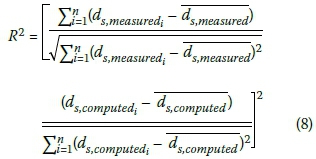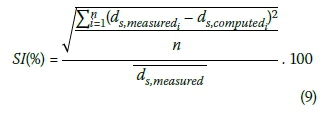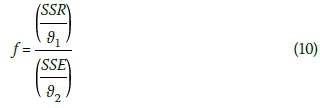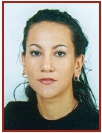Services on Demand
Article
Indicators
Related links
-
 Cited by Google
Cited by Google -
 Similars in Google
Similars in Google
Share
Journal of the South African Institution of Civil Engineering
On-line version ISSN 2309-8775
Print version ISSN 1021-2019
J. S. Afr. Inst. Civ. Eng. vol.58 n.3 Midrand Sep. 2016
http://dx.doi.org/10.17159/2309-8775/2016/v58n3a3
TECHNICAL PAPER
Experimental investigation of local scour around circular bridge piers under steady state flow conditions
A O Aksoy; O Y Eski
ABSTRACT
Local scour around bridge piers is one of the main causes of bridge failures. In this study, scour depths and scour hole geometries around circular bridge piers were investigated under clear water scour conditions for various flow rates. The experiments were carried out in a rectangular flume 80 cm wide, 18.6 m long and 75 cm high by using uniform sediment with a median diameter of 1.63 mm and geometric standard deviation of 1.3. The flow rates and approach flow depths were measured with an electromagnetic flow meter and ultrasonic level sensors, respectively. A new empirical equation for the determination of scour depth is proposed based on the experimental findings of the present study and on experimental data available in the literature. The experimental results were also compared with those calculated using several empirical equations developed by previous studies. The proposed new equation to predict scour depth around a circular bridge pier was evaluated in terms of determination coefficient (R2) and scatter index (SI). The Fisher (f)test was also applied to test the statistical significance of the proposed equation.
Keywords: bridge pier, scour hole geometry, clear-water scour, steady flow
INTRODUCTION
It has been estimated that 60% of all bridge failures result from scour and other hydrauli-cally related causes (Landers 1992). One of the most important steps in bridge design is to estimate the maximum local scour depths around bridge piers. Since the scour process is complex, the maximum scour depth cannot be determined analytically, and this has led many engineers to perform experiments to investigate local scour processes.
The effective variables affecting the local scour process are flow parameters, bed material characteristics, pier geometry and time. By means of dimensional analysis the following dimensionless parameters can be determined:

where Fr is the Froude number, Fdis the densimetric Froude particle number, y is the approach flow depth, D is the pier diameter, V is the approach flow velocity, Vcis the critical velocity, d50is the median particle size of the bed material, σgis the geometric standard deviation of the particle size distribution, K is the pier shape factor and Kais the alignment factor.
Many experiments have been carried out by many researchers, and various empirical equations have been proposed to estimate maximum scour depth. Laursen (1958), Breusers et al (1977), Gunyakti (1988) and Yanmaz (1989) proposed respective equations which are a function of approach flow depth (y/D). Hancu (1971) proposed an equation based on the dimensionless approach flow depth (y/D) and the Froude number (Fr). The empirical relation proposed by Melville (1997) involved flow intensity (V/Vc), particle size factor (Kd), pier shape factor (Ks), alignment factor (Ka) and channel geometry factor (Kg). Richardson and Davis (2001) proposed an equation based on the pier shape factor (Ks), alignment factor (Ka), bed condition factor (Kb), armouring factor (Kz), approach flow depth (y/D) and Froude number (Fr).
The temporal variation of the scour depth has also been investigated by researchers, and numerous empirical relationships have been determined based on experimental findings (Yanmaz & Altinbilek 1991; Kothyari et al 1992; Melville & Chiew 1999; Oliveto & Hager 2002; Mia & Nago 2003; Chang et al 2004; Kothyari et al 2007).
The range of conditions to which an empirical equation applies is very important. Therefore the aim of this study was to propose a widely applicable empirical equation based on a wide range of experimental data obtained from the present study and from available literature. One hundred and eighty two experimental results were used and the relevance of the proposed equation was tested statistically. The geometries of the scour holes obtained after each experiment were determined and are also presented to provide an indication of likely scour hole geometries.
EXPERIMENTAL SETUP AND EXPERIMENTAL RESULTS
The experiments were carried out in a rectangular flume 80 cm wide, 18.6 m long and 75 cm deep. Uniform granular sediment with median diameter d50 of 1.63 mm and geometric standard deviation of 1.3 were used in the model. The flow rates and approach flow depths were measured by using electromagnetic flow meter and ultrasonic level sensors, respectively. The slope of the flume was 0.6%. A sketch of the experimental set-up is given in Figure 1 The bridge piers were located at 11.5 m from the upstream end of the flume.
Circular bridge piers of 8 cm, 11 cm, 15 cm and 20 cm diameter were tested. The experiments were carried out using seven different steady flow rates of 43 ℓ/s, 47 ℓ/s, 53 ℓ/s, 57 ℓ/s, 62 ℓ/s, 66 ℓ/s and 71 ℓ/s. The reference of each experiment, pier diameter (D), flow rate (Q), approach flow depth (y) and flow intensity (V/Vc) is given in Table 1 The observed scour depth did not change after 320 minutes in the case of the largest pier diameter and flow rate. Since the duration of each experiment was 480 minutes, it was found that the change in the scour depth after this duration was negligible. Therefore the duration of the experiments was deemed to be sufficient to reach the equilibrium scour depth.

The critical velocity Vcwas determined from Equation 2 (Melville & Sutherland 1988).

where u.c is the critical shear velocity which can be calculated using the following relationship (Melville 1997):


In these relationships u*c is in m/s and sediment size is d50 in mm.
The scour holes measured after each experiment along the centre line of the flume are shown in Figure 2
The experimental findings are given in Table 2 where dsis the flume centre line maximum scour depth measured after each experiment, and Lsis the maximum extent of the scour hole upstream of the pier.

The experimental results showed the following:
■ The maximum scour depths occurred at the upstream face of the pier.
■ Scour depth increased with flow velocity and pier diameter.
■ The length of the deposit downstream of the pier and the length of the scour hole increased with flow velocity and pier diameter.
Figures 3(a), (b) and (c) show the variation in the dimensionless scour depth (ds/D) with densimetric Froude particle number (Fd), dimensionless approach flow depth (y/D) and relative sediment size (D/d50), respectively. The dimensionless scour depths increase with densimetric Froude particle number and dimensionless approach flow depth, as is clearly shown in Figure 3
Densimetric Froude particle number (Fd), can be calculated by using Equations 5 and 6 (Oliveyo & Hager 2002):


where psand ρ are the mass density of the sediment and water, respectively, and g is the gravitational acceleration.
Since the number of experiments described above was not sufficient to derive an empirical equation, 154 additional experimental findings obtained by previous studies were taken into account to propose a more comprehensive and general equation. Equation 7 is proposed by using the experimental data obtained from the present study and experimental findings obtained by Ettema (1980), Graf (1995), Yanmaz and Altinbilek (1991), Melville and Chiew (1999), Mia and Nago (2003), Oliveto et al (2003) and Sheppard et al (2004). Details of these previous studies are summarised in the Appendix. The total number of experiments used to derive the proposed equation is 182.

The comparison between the measured scour depths and those computed from Equation 7 are given in Figure 4 Equation 7 was evaluated in terms of determination coefficient (R2) and scatter index (SI). These parameters are defined as follows:


Determination coefficient (R2) and scatter index (SI) values are also shown in Figure 4 As shown in this figure, the measured and computed scour depths are in good agreement.
Measured scour depths were also compared with those calculated by using several equations given in the literature. The results are given in Figures 5(a) and 5(b). The maximum R2(coefficient of determination) value was obtained for each equation.
The Fisher (f) test was applied to check the statistical relevance of the proposed equation. The parameter f is defined as follows:

where SSR is the sum of squared residuals, SSE is the sum of squares for error, ϑ1 is the number of the independent variables (k), and ϑ2= n - k - 1, (n is the number of the data). SSR and SSE can be calculated from the following equations:

where  is the arithmetic mean of the observed and computed scour depth values.
is the arithmetic mean of the observed and computed scour depth values.
The critical value off is 3.78 for the selected 0.01 significance level. If the computed f value is greater than the critical value, then the proposed equation is significant. The f value was computed as 825 and therefore the proposed equation is significant.
The error between the measured scour depth and the scour depths estimated with Equation 7 were computed by means of the sum of errors squared (Sheppard et al 2011):

The SSE is calculated as 4.03%. Therefore the proposed equation is statistically consistent.
CONCLUSION
In this study the local scour around circular bridge piers was investigated experimentally. According to the experimental results, the scour depth increases with increasing pier diameter and flow velocity. It was observed that the length of the deposition downstream of the pier and the length of the scour hole also increase with flow velocity and pier diameter.
A new empirical relation to predict the maximum scour depth was proposed using the results of 182 experiments. Acceptable compatibility was obtained between the measured scour depths and the scour depths calculated by the proposed equation.
The significance of the proposed equation was demonstrated by applying the Fisher (f) test. The sum of squared errors (SSE) was calculated to be 4.03%, which indicates that the proposed equation is statistically consistent. The proposed equation was also evaluated in terms of determination coefficient (R2) and scatter index (SI), which were calculated to be 0.94 and 32%, respectively. These values also demonstrate the reliability of the proposed equation.
ACKNOWLEDGEMENT
The authors thank TÜBlTAK (project number 106M274 and 109M637) for financial support.
REFERENCES
Breusers, H N C, Nicollet, G & Shen, H W 1977. Local scour around cylindrical piers. Journal of Hydraulic Resources, 15(3): 211-252. [ Links ]
Chang, W Y, Lai, J S & Yen, C L 2004. Evolution of scour depth at circular bridge piers. Journal of Hydraulic Engineering, 130(9): 905-913. [ Links ]
Ettema, R 1980. Scour at bridge piers. Report No 216, Auckland, New Zealand: University of Auckland, School of Engineering. [ Links ]
Graf, W H 1995. Local scour around piers. In: Annual Report, Laboratoire de Recherches Hydrauliques, Ecole Polytechnique Federale de Lausanne, Lausanne, Switzerland, pp 33.1-33.8. [ Links ]
Gunyakti, A 1988. Köprü ayaklari etrafinda oyulma derinliginin grafikyöntemle tayini. Mühendislik ve Clevre Bilimleri Dergisi, TÜBÏTAK, The Scientific and Technological Research Council of Turkey, 12(1): 96-108. [ Links ]
Hancu, S 1971. Sur le calcul des affouillements locaux dans la zone des piles des ponts. Proceedings, 14th Congress, International Association for Hydrological Research (IAHR), Paris, France, Vol 3, pp 299-313. [ Links ]
Kothyari, U C, Garde, R J & Range Raju, K G 1992. Temporal variation of scour around circular bridge piers. Journal of Hydraulic Engineering, 118(8): 1091-1106. [ Links ]
Kothyari, U C, Hager, W H & Oliveto, G 2007. Generalized approach for clear-water scour at bridge foundation elements. Journal of Hydraulic Engineering, 133(11): 1229-1240. [ Links ]
Landers, M N 1992. Bridge scour data management. In: ASCE, Hydraulic Engineering: Saving a Threatened Resource - In Search of Solutions, Proceedings, Hydraulic Engineering Sessions at Water Forum '92, 2-6 August, Baltimore, Maryland. [ Links ]
Laursen, E M 1958. Scour at bridge crossings. Bulletin No. 8, Iowa Highway Research Board, Ames, IO. [ Links ]
Melville, B W 1997. Pier and abutment scour: Integrated approach. Journal of Hydraulic Engineering, 123(2): 125-136. [ Links ]
Melville, B W & Chiew, Y M 1999. Time scale for local scour at bridge piers. Journal of Hydraulic Engineering, 125(1): 59-65. [ Links ]
Melville, B W & Sutherland, A J 1988. Design method for local scour at bridge piers. Journal of Hydraulic Engineering, 114(10): 1210-1226. [ Links ]
Mia, F & Nago, H 2003. Design method of time-dependent local scour at circular bridge pier. Journal of Hydraulic Engineering, 129(6): 420-427. [ Links ]
Oliveto, G & Hager, W H 2002. Temporal evolution of clear-water pier and abutment scour. Journal of Hydraulic Engineering, 128(9): 811-820. [ Links ]
Oliveto, G, Unger, J & Hager, W H 2003. Discussion of "Design method of time dependent local scour at circular bridge pier" by Md. Faruque Mia and Hiroshi Nago. Journal of Hydraulic Engineering, 130: 1213. [ Links ]
Richardson, E V & Davis, S R 2001. Evaluating scour at bridges, 4th ed. Hydraulic Engineering Circular No 18, Federal Highway Administration Publication No FHWA-NHI 01-001, Washington, DC. [ Links ]
Sheppard, D M, Odeh, M & Glasser, T 2004. Large-scale clearwater local pier scour experiments. Journal of Hydraulic Engineering, 130(10): 957-963. [ Links ]
Sheppard, D M, Demir, H & Melville, B 2011. Scour at wide piers and long skewed piers. National Cooperative Highway Research Program Report 682, Transportation Research Board, Washington, DC. [ Links ]
Yanmaz, M & Altinbilek, H D 1991. Study of time- dependent local scour around bridge piers. Journal of Hydraulic Engineering, 117(10): 1247-1268. [ Links ]
Yanmaz, A M 1989. Time dependent analysis of clear water scour around bridge piers. PhD thesis, Ankara. Turkey: Middle East Technical University. [ Links ]
 Correspondence:
Correspondence:
A O Aksoy
Dokuz Eylul University
Department of Civil Engineering
Tinaztepe Campus
Buca
Izmir
Turkey
T: +0090 232 3017054
E: aysegul.ozgenc@deu.edu.tr
O Y Eski
Dokuz Eylul University
Department of Civil Engineering
Tinaztepe Campus
Buca
Izmir
Turkey
T: +0090 232 3017057
E: omer.yavuz.eski@hotmail.com

PROF AYSEGUL OZGENC ASKOY is an Assistant Professor in the Department of Civil Engineering at the Dokuz Eylul University (DEU), Turkey. She has a PhD in Hydraulics, Hydrology and Water Resources from the DEU. Her special interests are open channel flows, pipelines and numerical and physical modelling of hydraulic structures. She is a member of the Chamber of Civil Engineering in Turkey.

OMER YAVUZ ESKI has a degree in Civil Engineering and a Master's in Hydraulics, Hydrology and Water Resources from the Dokuz Eylul University (DEU), Turkey. He has two years' working experience in project design. He is a member of the Chamber of Civil Engineering in Turkey.
Details of the experimental results from previous studies

















